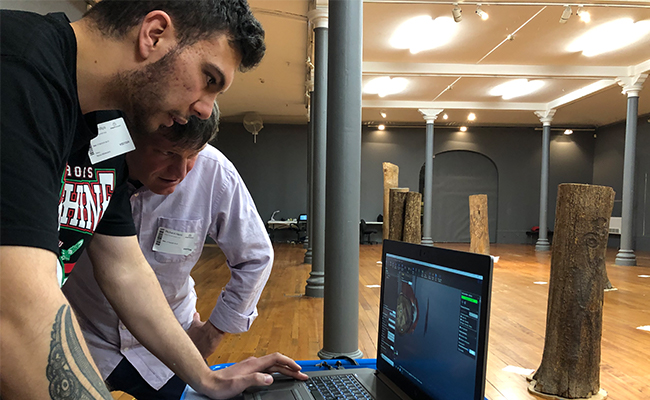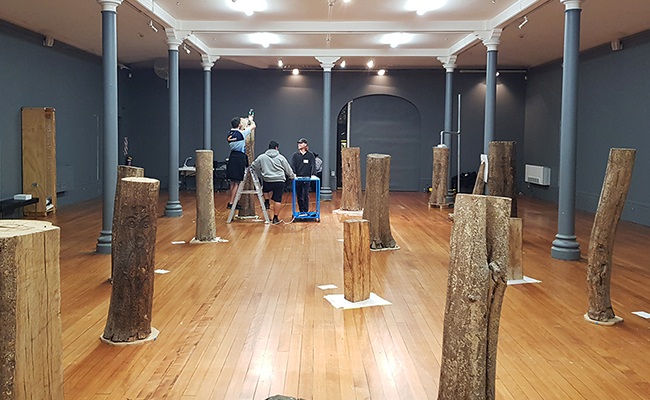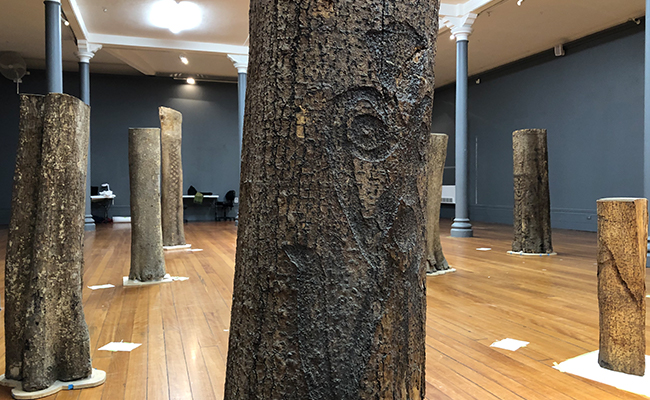Monday 21 September 2020 12:00pm

Professional Practice Fellow in the School of Surveying Richard Hemi with fourth year student Kade Phillips, who helped with scanning the rākau momori.
A decade ago Richard Hemi, from the School of Surveying was invited by the Department of Conservation (DOC) to Rēkohu (Chatham Islands) as part of a team to survey and scan a large number of engraved rākau momori (living tree engravings).
The experience turned out to be a career highlight for Mr Hemi, and it also facilitated the establishment of enduring research relationships with the University of Otago, particularly with Department of Archaeology’s Associate Professor Ian Barber.
Recently Mr Hemi was asked by Hokotehi Moriori Trust to be involved with a collaborative digital recording and conservation project of the engraved rākau momori held at the Otago Museum.
Collected from Rēkohu in the 1920s and 1960s, Otago Museum has 21 sections of kopi (karaka) trees in storage with carved engravings known as rākau momori.

The designs of these rākau momori are being digitally recorded for conservation.
The digital documentation process involved the use of laser technology to produce 3D colour scans of the rākau, along with higher resolution scans of the rākau momori.
Mr Hemi says the intention of this data is to create an extensive digital record to be made available for a variety of uses and platforms, as well as facilitating further potential research questions.
“Where the rākau are located in a landscape is an important part of their story, so to be able to recreate something resembling an idea of the landscape context using these scans will be a very valuable addition to their narrative.”
Dr Gerard O'Regan, Otago Museum’s curator Māori, has been working in museums since the 1980s and reflects on the traditional approach of many miheke (Moriori word for ‘taonga’) often being recorded on a simple catalogue card which, if lucky, may be accompanied by a photograph.
He says the 3D scans create many possibilities, including facilitating a connection to the miheke, which is important for underpinning the treasuring of heritage and the drive to conserve it.
Dr O’Regan also explains that what makes these rākau momori particularly interesting is the engagement of the rākau momori with the forest, and that the designs may relate to the landscape as well as with each other.
“Where the rākau are located in a landscape is an important part of their story, so to be able to recreate something resembling an idea of the landscape context using these scans will be a very valuable addition to their narrative.”

Only 55 rākau momori or living tree engravings remain in the forests on the Chatham Islands.
Historically there were thousands of these carvings all over Rēkohu but now just 55 remain in the forests, which adds an extra layer of importance to recording and preservation of these ones in the museum.
“Whether here or back on the Chathams, their documentation is absolutely essential for long-term preservation, as it will also provide improved security by allowing better monitoring of conservation and preservation over time,” Dr O’Regan says.
Hokotehi Moriori Trust enjoys strong collaborative relationships with a number of Otago University Departments which have resulted in beneficial research outcomes on Moriori history and culture.
The current work being undertaken by Hokotehi has been supported by the Lottery Environment and Heritage fund which, in addition to scanning and photographing the rākau momori, also includes a conservation assessment by Te Papa bark conservator Nirmala Balram.
Peter Latu, one of the School of Surveying students involved in the scanning project at the Otago Museum, says he was glad to be shoulder-tapped for this job.
“It’s one thing getting experience on hand-held and terrestrial scanners, but the fact the experience was with a very valuable and significant project, means it is easily one of the best projects I have taken part in.”
Kōrero by Guy Frederick, Communications Adviser (Sciences)
